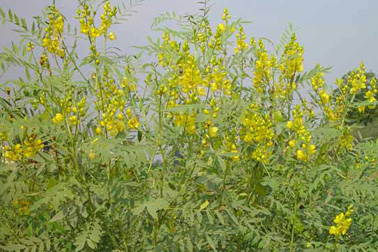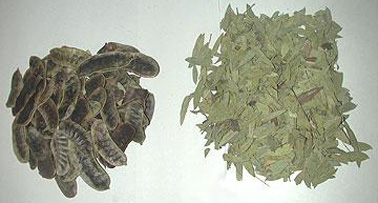|
Botanical Name:
Cassia augustifolia
Sonamukhi consists of the dried leaflets of Cassia
angustifolia Vahl, (Synonyms Cassia acutifolia Delile and
Cassia senna L), Family Fabaceae
Common Name(s) in English & Indian Languages
Sanskrit: Svarnapatri
Bengali: Sena
English: Senna
Guajarati: Sonamukhi
Hindi: Bhuikhakhasa, Hindisana, Sena
Kannada: Nelavare, Nelavarike, Sonamukhi
Malayalam: Nilavaka
Marathi: Bhitarvada, Mulkacha, Shonamakhi, Sonamukhi
Oriya: Sthalotpala
Tamil: Alakalampokkicceti, Putalamankaicceti,
Tirunelvelicenna
Telugu: Nelaponna, Nelatangedu
Urdu: Sana, Sana-I-Makki, Sena
Botanical description:
ALow shrubs, up to 1.5 m high, with compound paripinnate
leaves, having 3–7 pairs of leaflets, narrow or rounded,
pale green to yellowish green. Flowers, tetracyclic,
pentamerous, and zygomorphic, have quincuncial calyx, a
corolla of yellow petals with brown veins, imbricate
ascendent prefloration, and a partially staminodial
androeceum. The fruit is a broadly
elliptical, somewhat reniform, flattened, parchment-like,
dehiscent pod, 4–7 cm long by 2 cm wide, with 6 to 10 seeds
Parts used:
Leaflets
Major chemical constituent:
Hydroxyanthracene glycosides, small amounts of aloeemodin
and rhein
8-glucosides, mucilage, flavonoids, and naphthalene
precursors
Therapeutic uses:
• Diseases of abdomen (Udararoga)
• Constipation (Vibandha) |
|


|
|
|



